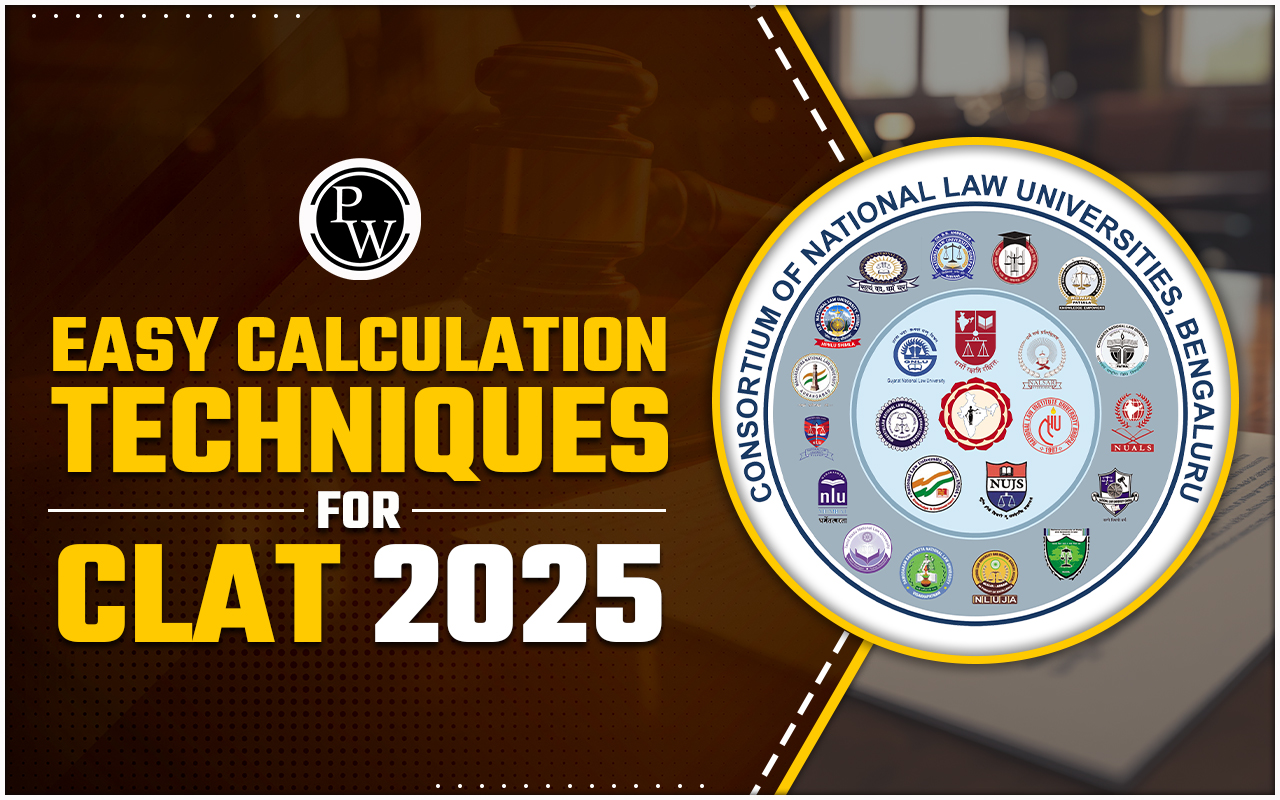
Easy Calculation Techniques for CLAT 2025 : The CLAT exam pattern for 2025 introduces significant changes to the Quantitative Reasoning section. Instead of focusing on basic mathematical problems, this section will now feature data interpretation questions based on tables, bar graphs, pie charts, and line graphs. To excel in this revised format, candidates need to develop strong skills in calculations and logical reasoning. This guide outlines effective calculation techniques that can help boost your performance in the CLAT 2025 exam.
Checkout Law Books from PW Store
What is the Digit Sum Method?
The Digit Sum Method, also known as "casting out nines," is a powerful arithmetic shortcut. This technique involves summing the digits of a number repeatedly until you get a single-digit result. This single-digit number, known as the "digital root," can help simplify various calculations.Also Read : CLAT 2025 Quantitative Techniques Syllabus
Why is it Relevant for CLAT?
The Digit Sum Method is especially useful in the CLAT exam for verifying calculations and eliminating incorrect options. Although it doesn't replace a deep understanding of math principles, it is a handy tool for checking your answers and ensuring accuracy.| Practical Applications | Example Applications |
| Verification of Arithmetic Calculations | Finding the Digit Sum |
| Quickly verify results of operations like addition, subtraction, multiplication, and division. | For the number 1238, the digit sum is calculated as follows: 1 + 2 + 3 + 9 = 14. Reduce 14 to a single digit: 1 + 4 = 5. Thus, the digit sum of 1238 is 5. |
| Eliminating Wrong Options | Checking Multiplication Results |
| Use digit sums to rule out incorrect multiple-choice answers. | To verify the result of 23 × 42: Digit sum of 23 is 5; digit sum of 42 is 6. Multiply these sums: 5 × 6 = 30; digit sum of 30 is 3. Ensure your multiplication result’s digit sum matches 3. |
| Time Management | |
| Save time by using digit sums for quick checks instead of redoing full calculations. | |
What is the Unit Digit Method?
The Unit Digit Method focuses on finding the last digit of a number's result in operations like multiplication and exponentiation. By isolating only the unit digits of numbers involved, you can simplify complex calculations and quickly find the last digit of the result.Also Read : CLAT Exam Pattern 2025
Why is it Relevant for CLAT?
This method is particularly useful for quickly solving questions where only the last digit of the result is needed. It helps in eliminating options and speeding up calculations, which is crucial in the timed environment of the CLAT.| Practical Applications | Example Applications |
| Eliminating Incorrect Choices | Finding Unit Digit in Multiplication |
| Use unit digits to narrow down multiple-choice answers. | To find the unit digit of 57 × 43: Focus on unit digits 7 and 3. 7 × 3 = 21; unit digit is 1. |
| Simplifying Complex Calculations | Determining Unit Digit in Exponentiation |
| Avoid lengthy calculations by focusing on unit digits. | For 7^4: The unit digit pattern of 7 is 7, 9, 3, 1. 7^4 ends in 1 (since 4 mod 4 = 0). |
What is the Approximation Method?
The Approximation Method simplifies complex problems by rounding numbers to make calculations easier. This method involves working with approximate values to quickly derive answers that are close to the exact result, saving time during the exam.Why is it Relevant for CLAT?
In the CLAT exam, where precise calculations are often less critical than logical reasoning, approximation allows you to handle complex numerical problems efficiently. This method can be particularly useful when exact figures are not required, and close estimates are sufficient.| Practical Applications | Example Applications |
| Handling Percentages | Percentage Calculation |
| Simplify calculations by rounding percentages and numbers. | To estimate 37% of 218: Round to 40% of 220. Approximate result: 40% of 220 = 88. |
| Simplifying Multiplication and Division | Multiplying Large Numbers |
| Use rounded numbers for quick calculations. | For 299 × 201: Round to 300 × 200 = 60,000. |
| Estimating Results | |
| Quickly compare answers by approximating values. |
Exam Day Tips
Also Read : How to balance Daily Routine for CLAT 2025 Preparation
Key Takeaways :
Analyzing Your Performance
